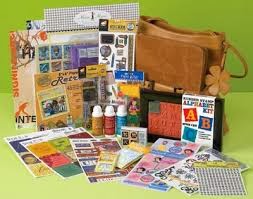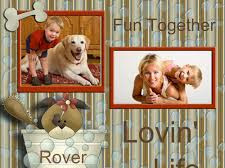Albums

Photo-friendly, acid-free albums are available in standard 8-1/2 x 11-inch, 12 x 12-inch, and 5 x 7-inch sizes. Most will let you insert plastic page protectors. The most popular types of scrapbooking albums are:
Three-ring: These familiar favorites have rings that snap apart for easy page insertion and removal.
Spiral-Bound: Albums with this type of wire binding have permanently attached pages and are ideal for one-topic and themed scrapbooks.
Strap-style: Albums that use plastic straps allow the pages to lie completely flat when the album is opened.
Adhesives
There are lots of different scrapbooking adhesives available, but some will work better than others for particular applications. You can choose from adhesives that set up instantly as well as repositionable adhesives that let you safely lift and rearrange elements (wet bonds usually are permanent while dry bonds usually are repositionable). Here are the most popular types of adhesives and the applications where each works best:
Double-sided tape and dots: Usually sold in plastic dispensers, and is available in both permanent and repositional adhesives. Adhesive dots are great for adhering smaller items to layouts and also are available in permanent and repositional forms.
Photo corners and sleeves: Photo corners with a peel-away backing come in sheets and rolls and in a variety of colors. Photo sleeves are made of clear plastic and have adhesive backing; they simply slip over your photos. Corners are ideal for attaching photos directly to layouts; sleeves work best for displaying photos that you may want to change later.
Spray Adhesives: Aerosol spray adhesives provide an even layer of glue that can cover large surfaces quickly. Sprays work well for adhering background papers or photo mats, and the dried adhesive won't show through transparent papers, such as vellum. Use spray adhesives only in well-ventilated areas and away from flames; never let children use them without adult supervision.
Liquid Adhesives: These come in a bottle, stick, pen, and wand applicators, and with thick or thin tips. The adhesive itself may be permanent or repositionable and fast- or slow-drying. Liquid adhesives work best for attaching small items such as punches or die-cut letters, or for tacking down dimensional items such as beads and buttons.
Adhesive Tabs: White and transparent double-sided adhesive tabs come in roll form and in refillable dispensers. They're great for adhering both small and large items with minimal mess.
Adhesive Foam: Use double-sided adhesive foam, dots, squares, and roll tape to secure items to your page and add dimension at the same time. They'll life die cuts, letters, and cropped photos up to a 1/2-inch from the page surface.
Embellishments
Use embellishments to personalize and enhance your scrapbook pages by highlighting photos, drawing attention to journaling, or helping to set a theme. Although nearly anything can work as an embellishment, these three are amongst the most popular:
Punches: Available in a variety of shapes and sizes, decorative paper punches let you create custom accents by punching shapes from whatever papers complement your layout.
Die Cuts: These premade paper shapes are available at most scrapbook and crafts stores and come in many shapes, sizes and colors. For a fee, some stores will let you use their die-cutting machine with your own papers to creat shapes and perfectly coordinate with your layout.
Stickers: Acid-free, photo-safe stickers come in thousands of different themes and sizes and are widely available in sheets and rolls.
Pens and Pencils
Lots of different writing utensils are safe to use on scrapbook pages, but look especially for those labeled "acid-free" or "photo-safe." Also choose products that will resist bleeding and fading. All come in a plethora of colors and sizes.
Gel Pens: These medium-line pens are ideal for journaling or outlining letters and embellishments, and they just come in just about every color imaginable.
Colored Pencils: Available in hundreds of hues, colored pencils are a scrapbooker's staple, ideal for shading and adding highlights to lettering and creating embellishments. Use them with a blender -- a clear, colorless pencil or pen -- to smooth and soften your colors.
Felt-tip Markers: Besides giving you a range of color choices, felt-tip markers also come in several different tip styles. Here are the four most common tips you'll find:
Chisel Point: This versatile marker has a tip with both broad and narrow edges and can produce distinctive decorative lettering and designs.
Monoline: These all-purpose pens have tips that range from very fine to thick (usually specified in millimeters). The round, tapered nibs can be used to create smooth lines for basic lettering techniques, captions, borders, line art, and illustrations, as well as to add details to letters made with other types of markers.
Scroll Point: This notched-tip marker produces a double line with just a single stroke. Use it to make basic block letters, design detailed borders, or draw straight double lines.
Brush Point: This marker has a flexible paintbrush-style tip, which is useful for adding ink to rubber stamps and for filling in shapes and letters.
Templates
Take advantage of many shapes and sizes of plastic templates to crop your photos, create embellishments and do dry embossing. Lettering templates also come in a range of sizes and type styles.
Scissors and Other Cutting Tools
Most cutting implements you'll find for sale will work fine for scrapbooking. Here are a few of the handiest and how best to use them.
Scissors: They come in straight- and decorative-edge styles. Long straight=edge scissors are useful for cutting large sheets of card stockand paper for freehand cropping photos. Small scissors work best for cutting out detailed embellishments. Decorative-edge scissors are ideal for cutting photo mats or anything to which you'd like to give a dressier look.
Crafts and Swivel Knives: Craft knives are perfect for making straight cuts on paper and card stock and for cropping photos. Swivel knives are similar to craft knives, but their rotating blade makes them better for cutting along curves or cutting out letters and template shapes. use these sharp tools with a self-healing or glass cutting mat.
Rotary Cutters: Often used to cut fabric, rotary cutters are also handy for cutting large sheets of paper and card stock or trimming photos. Use these tools with self-healing or glass cutting mats.
Paper Trimmers: This tool is handy for making square cuts and straight edges. The larger sizes are capable of handling even oversize sheets of paper and card stock.












































